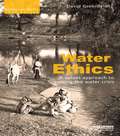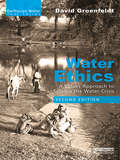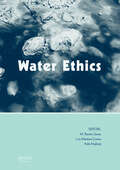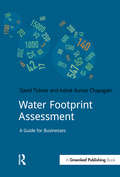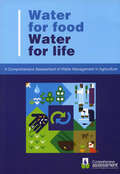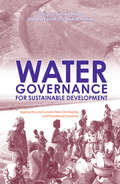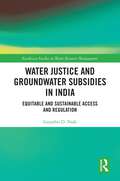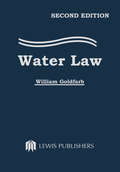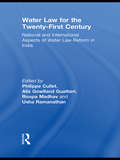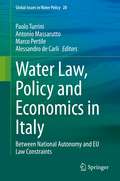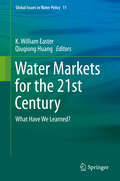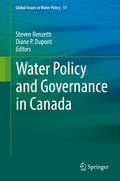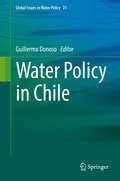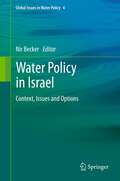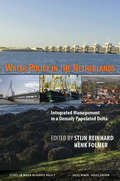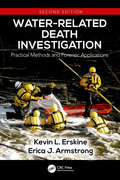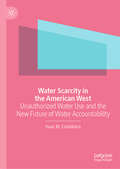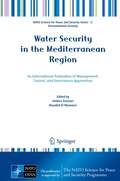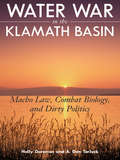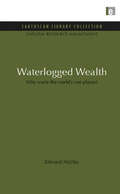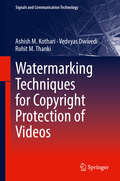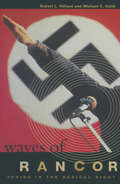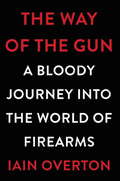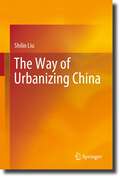- Table View
- List View
Water Ethics: A Values Approach to Solving the Water Crisis
by David GroenfeldtThis book introduces the idea that ethics are an intrinsic dimension of any water policy, program, or practice, and that understanding what ethics are being acted out in water policies is fundamental to an understanding of water resource management. Thus in controversies or conflicts over water resource allocation and use, an examination of ethics can help clarify the positions of conflicting parties as preparation for constructive negotiations. The author shows the benefits of exposing tacit values and motivations and subjecting these to explicit public scrutiny where the values themselves can be debated. The aim of such a process is to create the proverbial 'level playing field', where values favoring environmental sustainability are considered in relation to values favoring short-term exploitation for quick economic stimulus (the current problem) or quick protection from water disasters (through infrastructure which science suggests is not sustainable). The book shows how new technologies, such as drip irrigation, or governance structures, such as river basin organizations are neither "good" nor "bad" in their own right, but can serve a range of interests which are guided by ethics. A new ethic of coexistence and synergies with nature is possible, but ultimately depends not on science, law, or finances but on the values we choose to adopt. The book includes a wide range of case studies from countries including Australia, India, Philippines, South Africa and USA. These cover various contexts including water for agriculture, urban, domestic and industrial use, the rights of indigenous people and river, watershed and ecosystem management.
Water Ethics: A Values Approach to Solving the Water Crisis (Earthscan Water Text)
by David GroenfeldtFully revised and updated, this second edition of Water Ethics continues to consolidate water ethics as a key dimension of water-related decisions. The book introduces the idea that ethics are an intrinsic dimension of any water policy, program, or practice, and that understanding what ethics are being acted out in water policies is fundamental to an understanding of water resource management. Alongside updated references and the introduction of discussion questions and recommended further reading, this new edition discusses in depth three significant developments since the publication of the first edition in 2013. The first is the growing awareness of the climate crisis as an existential threat, and associated concern about adaptive strategies for sustainable water management and ways of using water management for climate mitigation (e.g., practically through agricultural soil management and conceptually through ethics awareness). Second, there has been increased clarity among the religious community, Indigenous leaders, and progressive academics that ethics needs to become an arena for application and action (e.g., the Vatican encyclical Laudato Si, protests at Standing Rock and Flint, Michigan, in the US, and climate demonstrations worldwide). Thirdly, there have been new normative water standards ranging from "water stewardship" (industry initiative), water charters (Berlin) and the on-going initiative to develop a global water ethics charter. Drawing on case studies from countries including Australia, India, the Philippines, South Africa, and the United States, this textbook is essential reading for students of environmental ethics and water governance and management.
Water Ethics: Marcelino Botin Water Forum 2007
by M. Ramón Llamas Luis Martínez-Cortina Aditi MukherjiIn the context of the current financial crisis, and at a time of deep global change, growing attention is paid to the global norms and ethical values that could underpin future global policy. Water is a key global resource. At the 3rd Marcelino Botin Foundation Water Workshop, held in Santander, Spain, June 12-14, 2007, the role of ethics in the de
Water Footprint Assessment: A Guide for Business (Doshorts Ser.)
by David Tickner Ashok Kumar ChapagainAs business risks associated with water intensify – for example risks to oeprations, supply chains and reputation – many corporate sustainability professionals are seeking practical tools to help them understand and assess these risks. Water Footprint Assessment tools developed primarily by the research sector are gaining attention in this context. However, there is debate among experts and non-experts about the merits of this approach. Water Footprint Assessment: A Business Guide is a concise and comprehensive digest of emerging concepts, tools and arguments around water footprint approaches. Specifically aimed at business audiences, this definitive short guide to the issues distils the latest in scientific and policy literature, helps sustainability leaders understand what they can, and can't do with water footprint tools, includes practical experience and case studies and outlines the pros and cons of using Water Footprint Assessment and similar approaches.
Water for Food Water for Life: A Comprehensive Assessment of Water Management in Agriculture
by David MoldenManaging water resources is one of the most pressing challenges of our times - fundamental to how we feed 2 billion more people in coming decades, eliminate poverty, and reverse ecosystem degradation. This Comprehensive Assessment of Water Management in Agriculture, involving more than 700 leading specialists, evaluates current thinking on water and its interplay with agriculture to help chart the way forward. It offers actions for water management and water policy - to ensure more equitable and effective use. This assessment describes key water-food-environment trends that influence our lives today and uses scenarios to explore the consequences of a range of potential investments. It aims to inform investors and policymakers about water and food choices in light of such crucial influences as poverty, ecosystems, governance, and productivity. It covers rainfed agriculture, irrigation, groundwater, marginal-quality water, fisheries, livestock, rice, land, and river basins. Ample tables, graphs, and references make this an invaluable work for practitioners, academics, researchers, and policymakers in water management, agriculture, conservation, and development. Published with IWMI.
Water Governance for Sustainable Development: Approaches and Lessons from Developing and Transitional Countries
by Stefano FarolfiGood management of water resources - universally identified as a key aspect of poverty reduction, agriculture and food security - has proven, in practice, as difficult to achieve as it is eagerly sought. This book, edited and authored by leading authorities on water resource management, examines the recent changes in governance, institutions, economics and policies of water, covering developing, transitional and developed countries, with special emphasis on southern African case studies. The book examines how water policies, institutions and governance have shifted in recent years from supply-driven, quantitative, centrally controlled management to more demand-sensitive, decentralized, participatory approaches. Such a move often also implies cost recovery principles, resource allocation among competing sectors, and privatization. The case studies demonstrate that the new policies and legal frameworks have been difficult to implement and often fall short of initial expectations. Using an accessible multidisciplinary approach that integrates economics, sociology, geography and policy analysis, the book untangles the issues and presents best practices for policy- and decision-makers, governments and regulators, NGOs and user groups, service providers, and researchers. The overall aim is to show how good water governance structures can be developed and implemented for the benefit of all.
Water Justice and Groundwater Subsidies in India: Equitable and Sustainable Access and Regulation (Earthscan Studies in Water Resource Management)
by Gayathri D. NaikThis book examines the impact of water-related subsidies on social and distributive equity and environmental sustainability in groundwater access and regulation in India.This book argues that adopting a water justice framework is essential to ensure equitable and sustainable access to and regulation of groundwater by balancing anthropogenic and ecological water needs. The inherent inequity resulting from property rights-controlled groundwater access gets widened by the social, political, and economic factors determining the subsidy beneficiaries. Adopting a socio-legal approach, this book draws on two contrasting case studies in India: Kerala, a water-secure state, and Rajasthan, an arid state. Arguing for a shift to a new paradigm in water governance, it critically examines the feasibility of the public trust doctrine and rights of nature discourse to analyse the best suitable regulatory framework that can balance the human right to water and ecological sustainability in groundwater resources. It demonstrates the feasibility of adopting various environmental law principles that balance human rights to water and nature. It argues that the hitherto highlighted public trust doctrine cannot address these inequities due to its anthropogenic bias and property rights link. This book examines the applicability of the rights of nature discourse instead of these property rights-based regulations to incorporate and mainstream the concerns of aquifer protection in water governance.This book shall be of great interest to students, scholars, and practitioners of water law and policy, environmental law, water and social justice, development studies, and political ecology.
Water Law
by William GoldfarbThis revised second edition is essential to everyone involved with water and water resources-complying with the myriad federal, state, and local laws and regulations that govern the use and management of water in our attempts to maintain, clean, usable water. It includes the law of water diversion and distribution; water resources development and protection; water treatment and land use; ocean dumping; oil and hazardous substances cleanup; riparian and non-riparian systems; Eastern permit systems; beneficial use; water codes; prior appropriation; surface and ground water; channel modifications; municipal water supply; irrigation; California Water Management Districts; Bureau of Reclamation; Corps of Engineers; Water Resources Development Act of 1986; SCS, TVA, BPA, NEA, CERCLA, CWA, SDWA, RCRA, and their substantial changes in the last four years; water resources planning and research; public use; ownership of beds and banks; wild and scenic rivers; river corridor and instream flow protection; flood insurance, Section 404 and Section 208; the Supreme Court and water conservation; heat dischargers; quality-based effluent limitations; state ground water programs; pretreatment; funding; enforcement; citizen suits; and many more vital topics.
Water Law for the Twenty-First Century: National and International Aspects of Water Law Reform in India
by Philippe Cullet Alix Gowlland-Gualtieri Roopa Madhav Usha RamanathanIn the face of growing freshwater scarcity, most countries of the world are taking steps to conserve their water and foster its sustainable use. Water crises range from concerns of drinking water availability and/or quality, the degradation or contamination of freshwater, and the allocation of water to different users. To meet the challenge, many countries are undergoing systemic changes to the use of freshwater and the provision of water services, thereby leading to greater commercialization of the resource as well as a restructuring of the legal, regulatory, technical and institutional frameworks for water. The contributions to this book critically analyse legal issues arising under international law, such as environment and human rights provisions, concerning the economic, environmental and social consequences of proposed water regulatory changes and their implementation at the national level. The book examines the situation in India which is currently in the midst of implementing several World Bank led water restructuring projects which will have significant impacts on the realisation of the right to water and all other aspects of water regulation for decades to come. In analysing the situation in India the volume is able to detail the interactions between international law and national law in the field of water, and to ask broader questions about the compliance with international law at the national level and the relevance of international law in national law and policy-making.
Water Law, Policy and Economics in Italy: Between National Autonomy and EU Law Constraints (Global Issues in Water Policy #28)
by Paolo Turrini Antonio Massarutto Marco Pertile Alessandro De CarliThis book provides the first comprehensive overview of the most important water-related issues that centre on Italy, analysed from several disciplinary perspectives – such as hydrology, economics, law, sociology, environmental sciences and policy studies – in order to promote full understanding of the challenges the country is facing and the ways it could best tackle them.Despite the misconception that Italy is a water-scarce country, is in fact quite rich in water resources. Such resources, however, are unevenly distributed over the Italian territory. Italy’s northern regions rely on quite an abundant quantity of freshwater, whereas in the southern area water endowment is limited. Moreover, climatic differences between North and South contribute to widen the divide. This disparity has notable consequences of socio-economic character, some of which, in turn, feed back into the environmental conditions of Italian regions: pollution, floods, landslides and droughts are among the problems affecting the country. There are numerous features of water use and consumption that distinguish Italy from other comparable countries, such as the significant role played by agriculture (a water-intensive activity), a lead position in the consumption of bottled water, lower-than-average prices of water and a far-from-optimal efficiency of waterworks. All such aspects, and many others, make Italy an essential case study.
Water Markets for the 21st Century
by K. William Easter Qiuqiong HuangThis book evaluates the history, the present and the future of water markets on 5 continents, beginning with the institutional underpinnings of water markets and factors influencing transaction costs. The book examines markets in seven countries and three different U. S. states, ranging from village-level water markets in Oman to basin wide formal water markets in Australia's Murray-Darling River basin. Introductory chapters on the background of water markets and on transaction costs and policy design are followed by chapter length discussion of water markets as an adaptive response to climate change and of supply reliability in a changing climate. Case studies describe a variety of facets of the design and function of markets around the world: California, Chile, Spain, Oman, Australia, Canada, India and China. In analyzing these real-world examples of markets, the contributors explore water rights and trading of rights between agricultural and urban sectors and the principles and function of option markets. They discuss different sized approaches, from large scale, ministry-level administration of markets to informal arrangements among farmers in the same village, or groups of villages which allocate water without large investment in management and infrastructure. Discussion includes questions of why water market practices have not expanded more rapidly in arid places. The book discusses mechanisms for resolving conflicts between water rights holders as well as between water right holders and third parties impacted by water trades and whether or not public ownership of water rights or use rights should trump private ownership and under what condition. Also covered are new and expanding categories of water use, beyond human consumption, agriculture and industry to new technologies ranging from extracting natural gas from shale to producing biofuels. The book concludes with suggestions for future water markets and offers a realistic picture of how they might change water use and distribution practices going forward.
Water Policy and Governance in Canada
by Steven Renzetti Diane P. DupontThis book provides an insightful and critical assessment of the state of Canadian water governance and policy. It adopts a multidisciplinary variety of perspectives and considers local, basin, provincial and national scales. Canada's leading authorities from the social sciences, life and natural sciences address pressing water issues in a non-technical language, making them accessible to a wide audience. Even though Canada is seen as a water-rich country, with 7% of the world's reliable flow of freshwater and many of the world's largest rivers, the country nevertheless faces a number of significant water-related challenges, stemming in part from supply-demand imbalances but also a range of water quality issues. Against the backdrop of a water policy landscape that has changed significantly in recent years, this book therefore seeks to examine water-related issues that are not only important for the future of Canadian water management but also provide insights into transboundary management, non-market valuation of water, decentralized governance methods, the growing importance of the role of First Nations peoples, and other topics in water management that are vital to many jurisdictions globally. The book also presents forward-looking approaches such as resilience theory and geomatics to shed light on emerging water issues. Researchers, students and those directly involved in the management of Canadian waters will find this book a valuable source of insight. In addition, this book will appeal to policy analysts, people concerned about Canadian water resources specifically as well as global water issues.
Water Policy in Chile (Global Issues in Water Policy #21)
by Guillermo DonosoThis book offers a detailed examination of the main sources of Chile’s water, its principle consumers, the gap between supply and demand, hydrological droughts, and future projected impacts of climate change. It describes, analyzes and evaluates the performance of water policies, laws and institutions, identifies the main challenges that Chile needs to face and derives lessons learnt from Chile’s reform experience.Expert contributors discuss such topics as Chile’s water policy, and the reasoning which explains its policy reform. The book presents and evaluates the performance of the legal and institutional framework of water resources. It also describes efforts to meet actual demands for water by augmenting supplies with groundwater management, waste water re-use and desalination and improve the state of water ecosystems. The last chapter presents the editor’s assessment and conclusions. The case of Chile is illustrative of a transition from command and control to market based management policies, where economic incentives play a significant role in water management.
Water Policy in Israel
by Nir BeckerThis book deals with water policy in Israel. It offers a detailed examination of the main sources of Israel's water, its principle consumers, the gap between supply and demand, and the complex, contentious work of analyzing and devising the nation's water management and use policies. Water Policy in Israel is arranged in five broad sections: The dynamics of moving from one policy era to another; Supply management; Demand management; The importance of the Sea of Galilee and the Dead Sea; and Regional and global issues including water conflict and cooperation and climate change.
Water Policy in the Netherlands: Integrated Management in a Densely Populated Delta
by Stijn Reinhard Henk FolmerAs a low-lying delta region with a high population density, the Netherlands has long focused on the prevention of flooding catastrophes and the reclamation of valuable land. The evolution of Dutch water governance, beginning with the creation of local 'water boards' in the Middle Ages and growing into a complex infrastructure of polders, dams, and controlled waterways offers a compelling study of pitfalls and successes within one of the worlds most challenging regions for water management. Water Policy in the Netherlands traces the arc of water governance in the country, from technological innovations to prevent wide-scale flooding, to strategies focused primarily on improving water quality, to an integral water management approach which brings together perspectives from economics, hydrology, ecology, water law, and water technology. The contributions in this book demonstrate how both the technical and social sciences must play key roles in crafting policy in the face of serious environmental challenges including climate change, sea level rise, and increasing soil subsidence. Innovative themes explored in the work include: how economic models and pricing structures might improve efficiency in the distribution of water resources, how the competing uses for water-including for recreation, arable agriculture, fisheries, and natural preservation-create demands on both the quantity and quality of water resources, and how public participation, cogovernance, and the balance of public and private interests will be necessary to meet the goals of the EU‘s Water Framework Directive. This resource serves as both an invaluable case study and as a text to develop the analytical tool of integral water management for students, policy-makers, and NGO professionals in developed and developing regions.
Water-Related Death Investigation: Practical Methods and Forensic Applications
by Kevin L. Erskine Erica J. ArmstrongNearly ten years after the first edition of Water-Related Death Investigation: Practical Methods and Forensic Applications, water death cases continue to be improperly investigated. The pathologist’s report can determine the cause of death as a drowning, but the manner of death is the most challenging to prove. The report will not determine if a victim jumped into the water to commit suicide, fell into the water accidentally, or was pushed in as a homicidal act. Many drowning cases do not reflect injury to the body, so evidence collected at the scene plays a vital role. The importance of an on-scene body assessment cannot be overemphasized. Often, the body evidence begins to change rapidly upon recovery and may not be present during an autopsy. Written statements on the scene are an effective tool to use to determine the accuracy of information given to arriving officers. These statements need to be written by the witnesses themselves as well as the reporting person. The "Show Me" technique can also help reveal discrepancies in a person’s version of what occurred as well as aid in providing the most details to an incident as is humanly possible. This second edition includes updated information on the latest technology to assist water death investigators. Parabon Snapshot can help determine the faceless identity of skeletal remains and help locate potential suspects using the science of DNA. Drones can aid in locating missing persons as well as human remains, even months after death. Updated information is provided regarding fingerprints from submerged objects, and Carbon-14 can help determine the origin of a found corpse. Key Features: Thoroughly reviews the physiological aspects of drowning Reveals the investigative characteristics inherent to various scenes of water-related deaths Highlights certain "red flag" indicators that may point to foul play or scene staging Outlines autopsy protocols, trial preparation, and expert witness testimony Provides numerous case studies and numerous illustrations to further clarify key points presented in the text Coauthored by a Master Water Death Investigator and an experienced forensic pathologist, Water-Related Death Investigation: Practical Methods and Forensic Applications, Second Edition merges the essentials of evidence collection and field investigation with autopsy best practices and laboratory testing. It will continue to serve as a valuable resource for the various professionals involved in these cases.
Water Scarcity in the American West: Unauthorized Water Use and the New Future of Water Accountability
by Isaac M. CastellanoThis book examines the role of unauthorized water use in the American West (Arizona, California, Colorado, Idaho, Montana, Nevada, New Mexico, Oregon, Utah, Washington, and Wyoming) and the coming demand for water accountability. Arguing that status quo responses to unauthorized water use (or water theft) and the protection of water rights are largely inadequate, this title examines the far-ranging impacts of this lackluster response on issues ranging from food production to urban livability, and concludes that there will be intense pressure at both the federal and state level to address these issues. Utilizing qualitative and quantitative models and collaborative management literature to identify ideal approaches, this project ultimately seeks to address this major crisis of states’ legitimacy and analyze potential solutions under the ever-expanding threat of climate change.
Water Security in the Mediterranean Region
by Andrea Scozzari Bouabid El MansouriThe role of water in our communities, from local to regional and right up to global levels, poses a series of key questions about climate change, about the anthropogenic impact on the environment, and about all the interconnected actions and events that affect the availability and quality of the resource. All these questions share a common demand for more scientific knowledge and information. In this particular context the disciplinary boundaries are fading, and there is a growing need to create broader connections and wider collaborative interdisciplinary groups, aimed at building an integrated knowledge-base to serve not only stakeholders but also the whole of society. Only in this way can we hope to respond effectively to the challenges and changing dynamics of human-hydrologic systems. Following this concept, contributors from multiple disciplinary backgrounds, such as Law Studies, Hydrogeology, Monitoring and Information Technologies, Geophysics, Geochemistry, Environmental Sciences, Systems Engineering, Economics and Social Studies, joined forces and interacted in this workshop. The present book reports the proceedings of this three-day ARW (Advanced Research Workshop), and explores different aspects of the environmental security assessment process, focusing on the assessment, monitoring and management of water resources, and giving an overview of the related scientific knowledge.
Water War in the Klamath Basin: Macho Law, Combat Biology, and Dirty Politics
by A. Dan Tarlock Holly D. DoremusIn the drought summer of 2001, a simmering conflict between agricultural and environmental interests in southern Oregon's Upper Klamath Basin turned into a guerrilla war of protests, vandalism, and apocalyptic rhetoric when the federal Bureau of Reclamation shut down the headgates of the Klamath Project to conserve water needed by endangered species. This was the first time in U.S. history that the headgates of a federal irrigation project were closed--and irrigators denied the use of their state water rights--in favor of conservation. Farmers mounted a brief rebellion to keep the water flowing, but ultimately conceded defeat. In Water War in the Klamath Basin, legal scholars Holly Doremus and A. Dan Tarlock examine the genesis of the crisis and its fallout, offering a comprehensive review of the event, the history leading up to it, and the lessons it holds for anyone seeking to understand conflicts over water use in the arid West. The authors focus primarily on the legal institutions that contributed to the conflict--what they call "the accretion of unintegrated resource management and environmental laws" that make environmental protection so challenging, especially in politically divided regions with a long-standing history of entitlement-based resource allocation. Water War in the Klamath Basin explores common elements fundamental to natural resource conflicts that must be overcome if conflicts are to be resolved. It is a fascinating look at a topic of importance for anyone concerned with the management, use, and conservation of increasingly limited natural resources.
The Watergate Girl: My Fight for Truth and Justice Against a Criminal President
by Jill Wine-BanksObstruction of justice, the specter of impeachment, sexism at work, shocking revelations: Jill Wine-Banks takes us inside her trial by fire as a Watergate prosecutor. It was a time, much like today, when Americans feared for the future of their democracy, and women stood up for equal treatment. At the crossroads of the Watergate scandal and the women’s movement was a young lawyer named Jill Wine Volner (as she was then known), barely thirty years old and the only woman on the team that prosecuted the highest-ranking White House officials. Called “the mini-skirted lawyer” by the press, she fought to receive the respect accorded her male counterparts—and prevailed.In The Watergate Girl, Jill Wine-Banks opens a window on this troubled time in American history. It is impossible to read about the crimes of Richard Nixon and the people around him without drawing parallels to today’s headlines. The book is also the story of a young woman who sought to make her professional mark while trapped in a failing marriage, buffeted by sexist preconceptions, and harboring secrets of her own. Her house was burgled, her phones were tapped, and even her office garbage was rifled through.At once a cautionary tale and an inspiration for those who believe in the power of justice and the rule of law, The Watergate Girl is a revelation about our country, our politics, and who we are as a society.
Waterlogged Wealth: Why waste the world's wet places? (Natural Resource Management Set)
by Edward MaltbyDon't drain the swamp! Man's traditional response to swamps, marshes and bogs has been to drain them. But wetlands are not wastelands. Coastal marshes are among the world's most productive ecosystems. They make many commercial fisheries possible and protect coasts from floods and storm surges. Wetlands are pollution filters, water reservoirs. They are among the last wild places on earth, offering homes to endangered plants, birds and animals. Attitudes to wetlands are changing, but not fast enough. As scientists are documenting the wealth in wet places, governments and developers are draining them, damming them, logging them and building resort hotels where ', they once were. Destruction is usually a poor trade-off: well-managed wetlands in Louisiana are producing fortunes in seafood and timber. Waterlogged wealth examines the value of swamps and marshes, as well as the threats against them. In doing so it takes the reader to some of the world's most bizarre landscapes: the 'inland delta' of the Niger River in drought-stricken Mali; the wildlife-rich Okavango swamps of Botswana; the waterlogged Sunderban forests of India and Bangladesh, where tigers eat fish and crabs. Civilisation began around wetlands; today's civilisation has good reason to leave them wet and wild. Dr Edward Maltby is a lecturer in geography at the University of Exeter(UK). He has done extensive research on wetlands both in the North (UK, US, Canada) and the South (Fiji, Jamaica, India and the Falklands/Malvinas Islands). He is on the IUCN Wetland Programme Advisory Committee. Originally published in 1986
Watermarking Techniques for Copyright Protection of Videos (Signals and Communication Technology)
by Ashish M. Kothari Vedvyas Dwivedi Rohit M. ThankiThe book provides copyright protection approaches for videos using watermarking. The various watermarking techniques using various transforms such as discrete cosine transform (DCT), discrete wavelet transform (DWT) and singular value decomposition (SVD) for videos are presented. The book also provides video watermarking approach using compressive sensing (CS) theory. The presented watermarking techniques are designed and implemented using color digital videos. The performance of the presented techniques is evaluated using Peak Signal to Noise Ratio (PSNR) and Normalized Correlation (NC).
Waves of Rancor: Tuning into the Radical Right
by Robert L. Hilliard Michael C. KeithThe airwaves in America are being used by armed militias, conspiracy theorists, survivalists, the religious right, white supremacists, neo-Nazis, and other radical groups to reach millions with their messages of hate and fear. Waves of Rancor examines the origin, nature, and impact of right-wing electronic media, including radio, television, cable, the internet, and even music CDs.
The Way of the Gun: A Bloody Journey into the World of Firearms
by Iain OvertonA "riveting," "relentlessly engrossing," and "brilliantly researched" investigation of the life of the gun -- its manufacture, its sale, and its impact -- and of our world's hugely complex relationship with firearms.In some places of the world, getting a gun is easier than getting a glass of water. In some parts of the world, an individual is allowed to carry concealed firearms into schools. In some parts of the world, there are more guns than people to shoot them. There are almost 1 billion guns across the globe today, a shocking number that is higher than ever before in history. Each year, 12 billion bullets are produced -- almost two bullets for every person on the planet. And over 300,000 people are shot dead over an average year worldwide. In The Way of the Gun award-winning investigative journalist Iain Overton takes readers on a shocking and eye-opening journey to over 25 cities all across the globe, from Cape Town to Tokyo, from San Pedro Sula to Phnom Penh, along the way encountering people from all walks of life affected by guns: Zionist anti-terror gun trainers; El Salvadoran gangland killers; porn starlets who appear as snipers in triple-X films; and South African doctors soaked in the blood of gunshot victims -- unearthing some hard truths about the terrible realities of war and gun crime. Harrowing and sobering, this riveting expose on the long-reaching and mostly unknown life of a gun is an essential and important book in today's world.From the Hardcover edition.
The Way of Urbanizing China
by Shilin LiuThe book conducts a comprehensive research study on China’s urbanization. It puts forward three theoretical development models of urban planning in China, i.e., the politics-oriented city, the economy-oriented city and the human-oriented cultural city. It makes objective evaluations of the development models of the politics-oriented city and the economy-oriented city. It suggests that relations between the government and the market should be straightened out to solve the hangovers of the development model of the politics-oriented city, and eco-civilization development and cultural development should be put on the top of the government’s agenda in order to cope with the recurring problems and complications brought about by the development model of the economy-oriented city.
